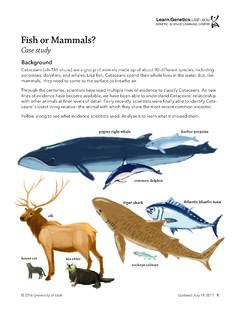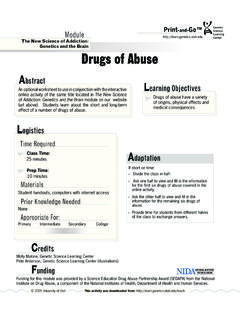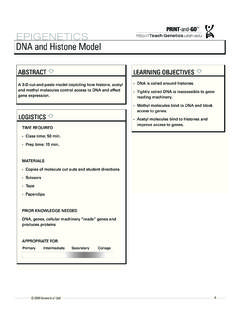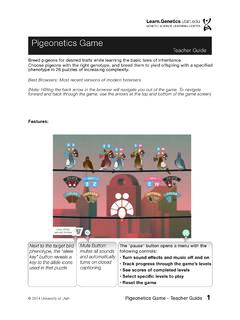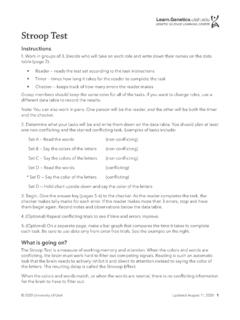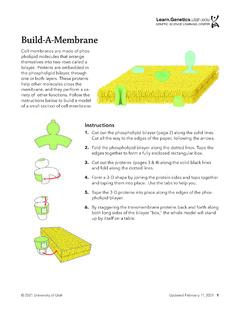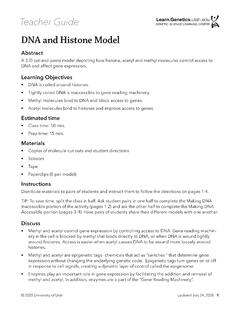Transcription of Investigating Reproductive Strategies
1 There are two modes of reproduction, sexual and are advantages and disadvantages to both sexual and asexual information sheets for 12 reference list for more information about the organisms used in this list of learning objectives and key ideas to help you guide classroom discussion during the Features You ll Find InsideClass Time:50 minutes10 minutes to review activity and make copies of student pagesPrep Time:LogisticsTime RequiredCopies of student pagesNoneMaterialsPrior Knowledge NeededAppropriate For:Students work in pairs to compare five aspects of an organism that reproduces sexually with one that reproduces asexually. As a class, students share their comparisons and generate a list of general characteristics for each mode of reproduction, and discuss the advantages and disadvantages of Objectives 2008 University of Utah This activity was downloaded from: Reproductive StrategiesPrimary Intermediate Secondary College 1.
2 Divide students into Hand each pair: The Investigating Reproductive Strategies worksheet (page S-1) 2 organism descriptions - one for an organism that reproduces sexually and one for an organism that reproduces either asexually or using both Strategies - (see chart below).3. Instruct each pair to read about their assigned organisms and complete the comparison table on the Investigating Reproductive Strategies When all pairs have completed the comparison table, have them post their tables around the Ask students to walk around the room and read the comparison tables with the goal of creating a list of general characteristics for organisms that reproduce sexually and one for organisms that reproduce asexually. 6. As a class, compile lists of general characteristics for organisms that reproduce sexually and asexually on the board. Learning objectives and discussion points for each category on the Investigating Reproductive Strategies worksheet are listed on pages 2-4 to help you guide the Ask students to discuss the advantages and disadvantages of each mode of reproduction in their pairs.
3 Have them prepared to support their Add advantages and disadvantages to the list of general characteristics for each mode of reproduction. 9. Lead a discussion on the types of situations or conditions in which each mode of reproduction would be most advantageous or disadvantageous. Do students think one Reproductive mode is generally better? Why?Classroom ImplementationSexualAsexualBoth Sexual and AsexualBlue-headed wrasseAmoebaBrittle starDuck leechSalmonellaMeadow garlicGrizzly bearWhiptail lizardSpiny water fleasLeafy sea dragonRed kangarooSand scorpionReproductive Strategies used by organisms described in this ac-Tip: You may wish to have students record their ideas on a sheet of paper while they read the comparison tablesInvestigating Reproductive Strategies 2008 University of Utah This activity was downloaded from: complexity of organism (including size)Learning Objectives/Discussion Points: Complex organisms tend to reproduce Objectives/Discussion Points: Simple organisms tend to reproduce of parents who contribute genetic information to the offspringLearning Objectives/Discussion Points: Two parents contribute genetic information.
4 Offspring are unique from their parents and from each Objectives/Discussion Points: One parent contributes genetic information. Offspring are exact genetic copies (clones) of the mechanismLearning Objectives/Discussion Points: Gametes from two parents join. With sperm fertilize eggs inside the body, the chances of gametes meeting are increased. Each individual may produce fewer eggs and/or sperm. When eggs and sperm are released to join outside the body, the gametes have a lower chance of meeting. Organisms that reproduce in this way must produce many Objectives/Discussion Points: Asexual reproduction does not involve gametes. Reproduction is by splitting in half, or forming new individuals that are released from the parent. What are the advantages and disadvantages of sexual and asexual reproduction? Is one better than the other? You are an Ecologist who wants to find out. You decide to compare 5 aspects of organisms that reproduce sexually with ones that reproduce asexually.
5 You will begin by looking at two organisms. Once you make your comparisons, you will share your information with all of the other ecologists in your class to draw general conclusions about each method of reproduction. Fill in the table below with information for each organism you have been assigned. Investigating Reproductive Strategies 2008 University of Utah This activity was downloaded from: ObjectivesSexualAsexualRelative amount of parental careLearning Objectives/Discussion Points: Offspring tend to have longer gestation periods, and developing offspring are protected. Parents tend to care for their young, increasing the chances that offspring will survive. Organisms that invest time and energy in caring for their young tend to have fewer offspring. Some sexually reproducing organisms neither gestate nor care for their young. These offspring are vulnerable to predators or the environment. These organisms tend to produce large numbers of gametes and/or offspring.
6 This increases the chances that some offspring will survive and reproduce. Learning Objectives/Discussion Points: Offspring receive little or no parental care. Organisms that reproduce by forming new individuals that separate from the parent do provide a form of parental care before the offspring are released. Organisms that do not care for their young tend to produce large numbers of offspring. Organisms where few offspring survive to reproduce have large numbers of offspring. Organisms that split to produce an adult offspring often can rapidly reproduce variation in offspringLearning Objectives/Discussion Points: Genetic variation comes only from sexual reproduction, in which genetic information from two parents combines. Genetic variation helps a species (as a whole) survive. In the event of a change in environment or increased competition for resources, some organisms may have slight trait variations (due to genetic variation) that allow them to survive.
7 Over time, natural selection may favor these differences, resulting in new Objectives/Discussion Points: Offspring have little to no genetic variation. (note: variation does still arise through random mutation) In the event of a change in environment or competition for resources, offspring may not have trait variations that will allow them to survive. If a parent has traits that are well adapted to a particular environment, its offspring will have these same traits, which may provide them with a survival Reproductive Strategies 2008 University of Utah This activity was downloaded from: ObjectivesOverall Learning Objectives/Discussion Points There are advantages and disadvantages to both sexual and asexual reproduction. For an individual it is best if the greatest number of its offspring survive to reproduce, carrying its genes into the next generation. Some species produce large numbers of offspring, but only a few may survive to reproduce.
8 Other species produce few offspring, but parents provide extended care to improve each offspring s chance of survival. For a species it is best if individuals survive and reproduce so that the species does not go extinct. Genetic variation, through new combinations of alleles, results only from sexual reproduction. Certain variations may help individuals survival and reproduce, giving the population the potential to adapt to new and changing environments. Organisms that can use both sexual and asexual modes of reproduction may be most adaptable to different conditions. Investigating Reproductive Strategies 2008 University of Utah This activity was downloaded from: (All websites accessed May 2008)Amoeba (Amoeba proteus)Anderson OR. 1988. Comparative Protozoology: Ecology, Physiology, Life History. M. 1989. Protozoa and other protists. Edward Arnold of Life Web Project: A. 1980. Generation times and Reproductive rates of Amoeba proteus as influenced by temperature and food concentration.
9 Canadian Journal of Zoology 58(4): ~wiser/protozoology/ Bear (Ursus arctos horribilis)Defenders of Wildlife, Grizzly Bear Fact Page: JJ, Sumner JS and Mitchell JA. 1995. The grizzly bears of Yellowstone: their ecology in the Yellowstone ecosystem. Island Kangaroo (Macropus rufus)Dawson TJ. 1995. Kangaroos: biology of the largest marsupials. Comstock M. 2001. Macropus rufus (On-line), Animal Diversity Web. Leech (Theromyzon tessulatum)Sawyer RT. 1986. Leech biology and behaviour. Volume I: anatomy, physiology, and behaviour. Clarendon RW. 1991. Annelida: leeches, polychaetes, and acanthobellids. In: [Thorp JH and Covich AP. eds Ecology and Classification of North American Freshwater Invertebrates. Academic Press, J and Davies RW. 1980. The population ecology of the leech (Hirudinoidea: Glossiphoniidae) Theromyzon tessulatum. Canadian Journal of Zoology 58: J and Davies RW. 1980. The Reproductive biology of Theromyzon tessulatum (Glossiphoniidae: Hirudinoidea), with comments on Theromyzon rude.]
10 Journal of Zoology London. 192: Garlic (Liliaceae: Allium canadense)Connecticut Botanical Society: Reproductive Strategies 2008 University of Utah This activity was downloaded from: of the Southeastern US: Wildflowers of Illinois, by John Hilty: Grassland Whiptail Lizard (Cnemidophorous uniparens)Crews D. 1987. Courtship in unisexual lizards: A model for brain evolution. Scientific American 255: DL. Everything you wanted to know about whiptail lizards (Genus Cnemidophorus) and quite a lot that you didn t. ~ (Salmonella typhimurium)Saeed AM. 1999. Salmonella enterica Serovar Enteridis in Humans and Animals. Iowa State University C and Kyriakides A. 2002. Salmonella: a practical approach to the organism and its control in foods. Blackwell R. 1992. Salmonella. CRC for Disease Control, salmanellosis. Scorpion (Paruroctonus mesaensis)Polis G and Farley R. 1979. Characteristics and environmental determinants of natality, growth and maturity in a natural population of the desert scorpion, Paruroctonus mesaensis (Scorpionida: Vaejovidae).
